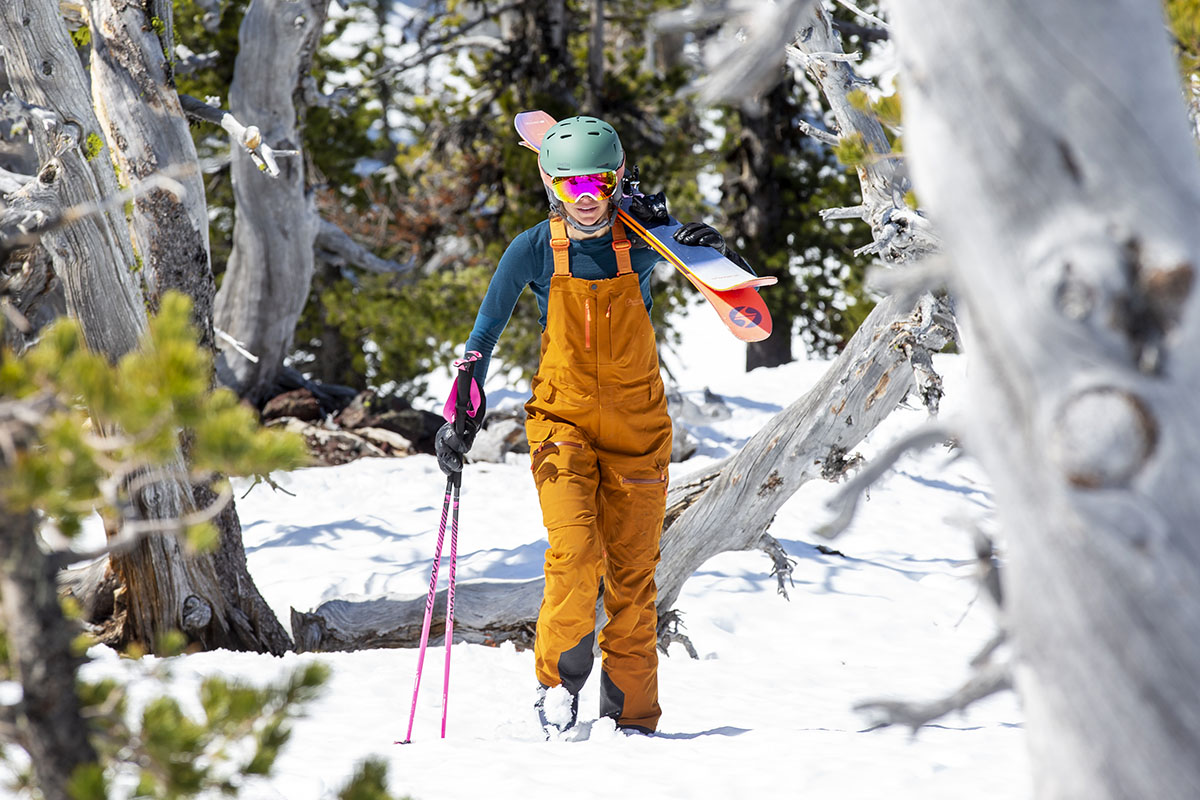
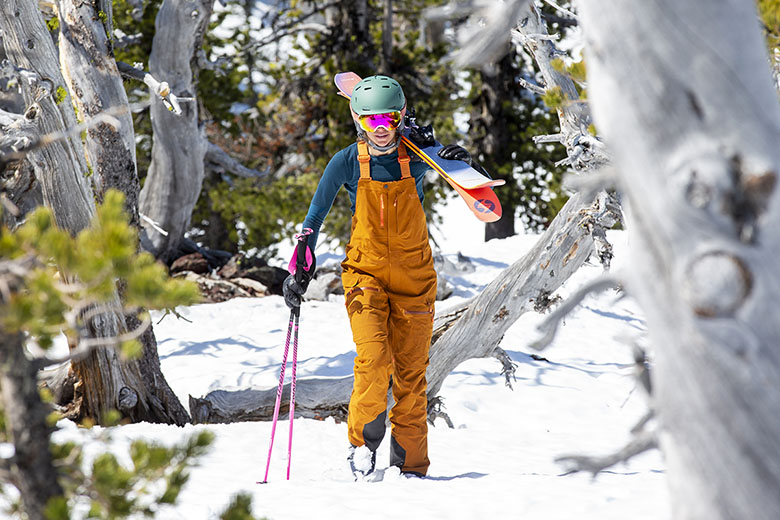
Switchback Travel (Jon Tapper)
Price: $499
Weight: 1 lb. 15 oz. (size small)
Waterproofing: 3L PNW Primo
What we like: High on protection and durability, well-executed storage layout, and versatile fit.
What we don’t: Too thick and heavy for dedicated backcountry use (though it’s fine for short tours).
See the Women's Chariot Bib Primo See the Men's Trewth Bib Primo
Oregon-based Trew Gear is a relatively young brand but has wasted no time assembling a solid lineup of high-quality and clean-looking ski kits. We recently put the women’s Chariot Bib Primo to the test in central Oregon and came away with high praise regarding protection, durability, and comfort. Along with a premium fit and finish and stylish freeride aesthetic, the Chariot Bib is an excellent quiver-of-one option for resort-goers who embark on the occasional tour. The bib is too thick and heavy for frequent backcountry use, but its overall performance and build quality are top-notch. Below we break down our experiences with the Chariot Bib Primo. To see how it stacks up to the competition, see our articles on the best women’s ski bibs and best women's snowboard pants.
Central Oregon experienced one of its stormiest winters in recent history last year, and the Trew Gear Chariot Bib Primo handled the challenging conditions with aplomb. The in-house 3-layer PNW Primo construction is reminiscent of premium Gore-Tex in both look and feel, and it's done an admirable job of keeping me dry and comfortable in everything from thigh-deep powder to icy rime and gale-force winds. To maximize weatherproofing, Trew Gear didn’t skimp on the details: You get full seam taping, water-resistant zippers on all of the pockets and vents, stretchy internal gaiters, and generous torso coverage (the bib reaches almost to my armpits) that’s highly effective at sealing out snow, even in the event of a fall. All told, whether I was getting coated with rime on a chairlift, teaching layer identification in a snow pit, or digging out a snowmobile in waist-deep powder, the Chariot Bib Primo proved to be a trustworthy and confidence-inspiring companion.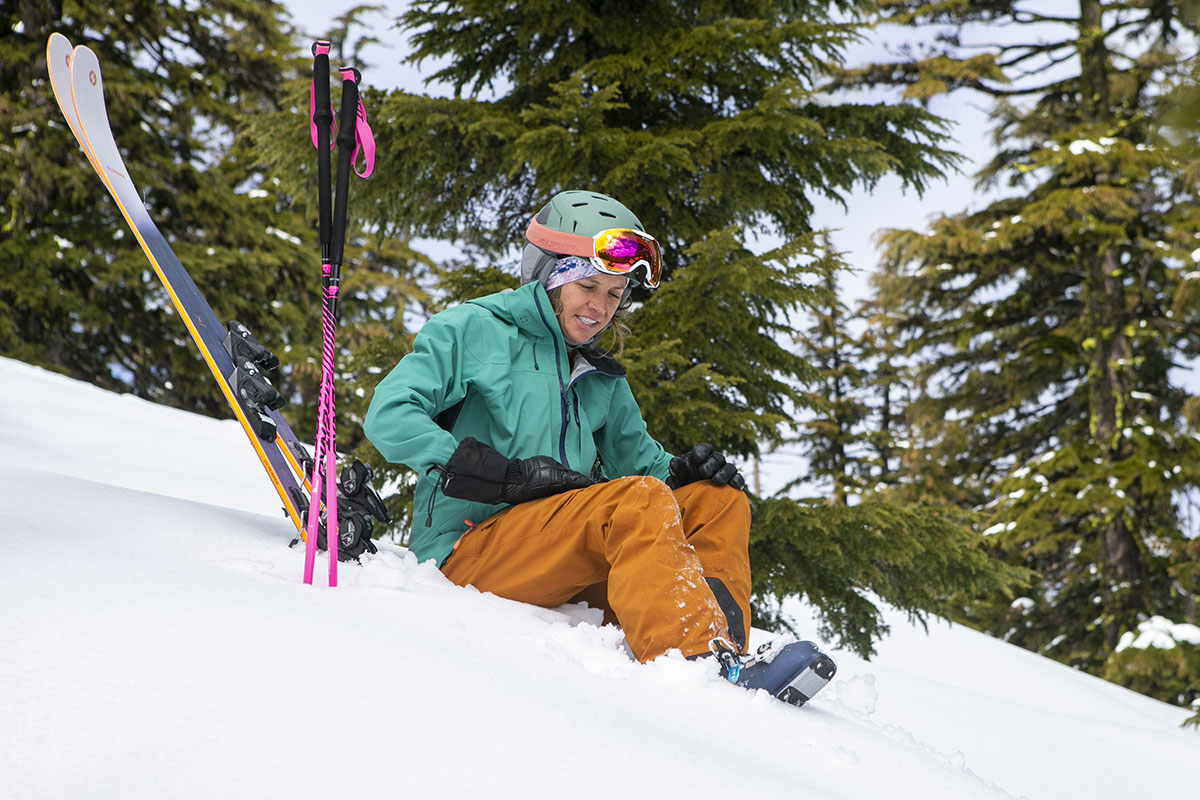
Unfortunately, the Chariot Bib Primo’s robust and protective build has a negative impact on breathability. The bib's thick fabrics lack the air permeability of thinner designs, and the high-riding upper that covers most of the torso only makes matters worse. To help with airflow, Trew Gear included thigh vents at the inside of each leg that extend to just above the knee for dumping excess heat. Paired with a light- or midweight baselayer, I was able to stay comfortable while guiding, wrangling snowmobiles, standing in snow pits, and resort skiing—i.e., activities that don’t require working up a major sweat. For fast-and-light backcountry missions, however, I’d recommend going with a more breathable alternative like the Outdoor Research Skytour AscentShell Bibs or Trew Gear’s own Capow Bib, which uses a mix of softshell and stretch-infused hardshell fabrics and has a noticeably lower cut.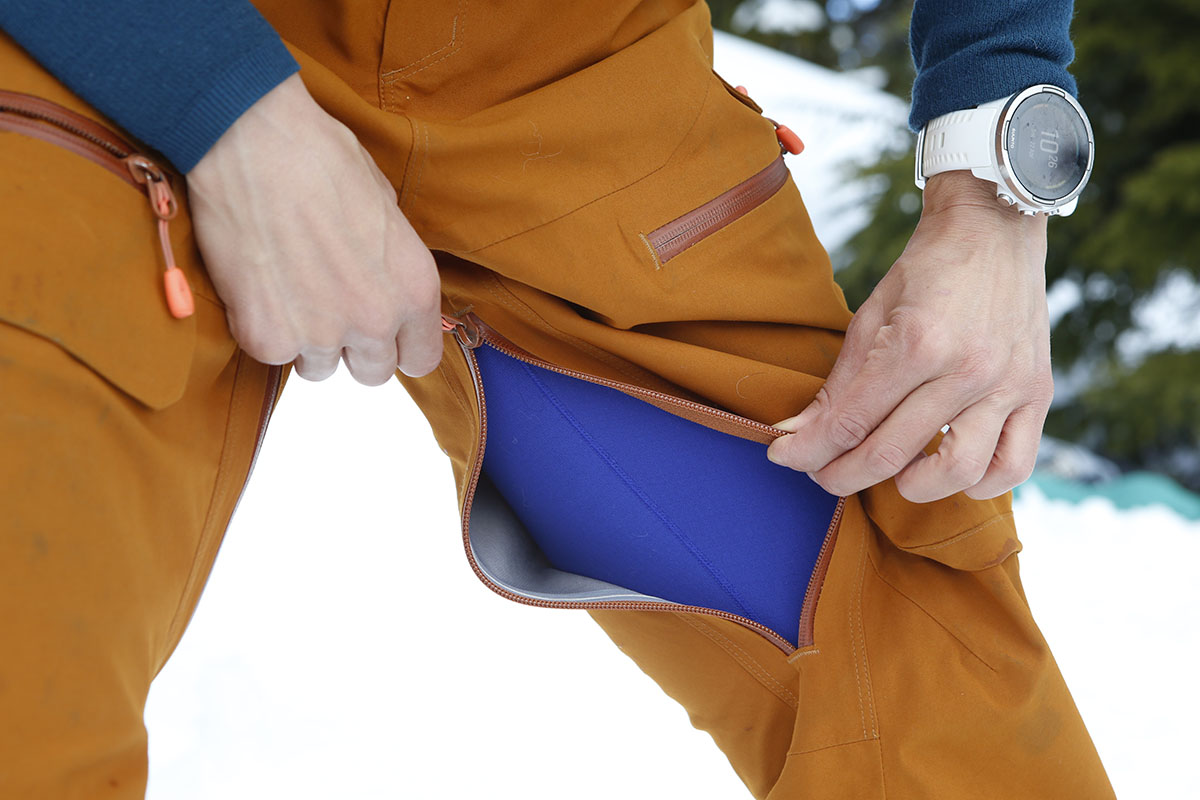
The Trew Gear Chariot Bib Primo scores high marks in the comfort department. While not particularly stretchy, the 3-layer PNW Primo fabric has enough “give” that it feels supple rather than stiff and promotes good all-around mobility. The relaxed fit is also helpful for maximizing range of motion (more in “Fit and Sizing” below), and the suspenders feature wide and stretchy straps that are easy to adjust and don’t dig into the shoulders. I spent countless days last winter digging snow pits, burying mock victims for avalanche beacon search drills, getting on and off snowmobiles and ski lifts, breaking trail in deep snow, and skiing everything from whiteout conditions to corn. Through it all, the Chariot Bib Primo impressed me with its unrestrictive and pliable feel.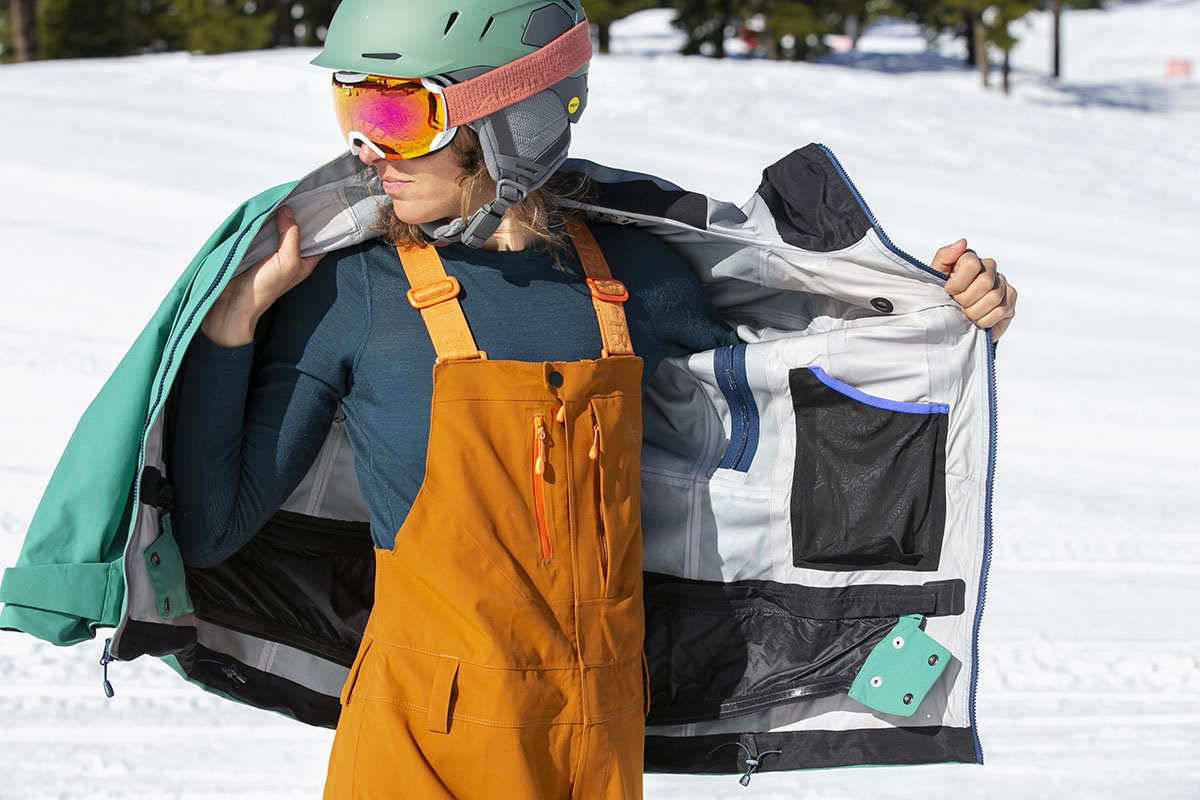
After spending around 80 days on snow last season, I can confidently say that the Chariot Bib Primo is an impressively well-built and durable piece. I’m admittedly hard on my gear and have a knack for breaking zippers and puncturing holes in my ski kit, but the Chariot has deftly withstood all the abuse. Aside from a bit of snowmobile grease on the thighs and some scuffing and small slashes on the inside of each cuff, the bibs look almost like new with no snags, tears, or malfunctioning zippers or drawcords. The internal gaiters are also in great shape, which was a nice surprise given that most of my other ski pants have shown considerable wear in this area. All in all, I have a lot of confidence in the Chariot Bib Primo and expect it to hold up very well over the long term.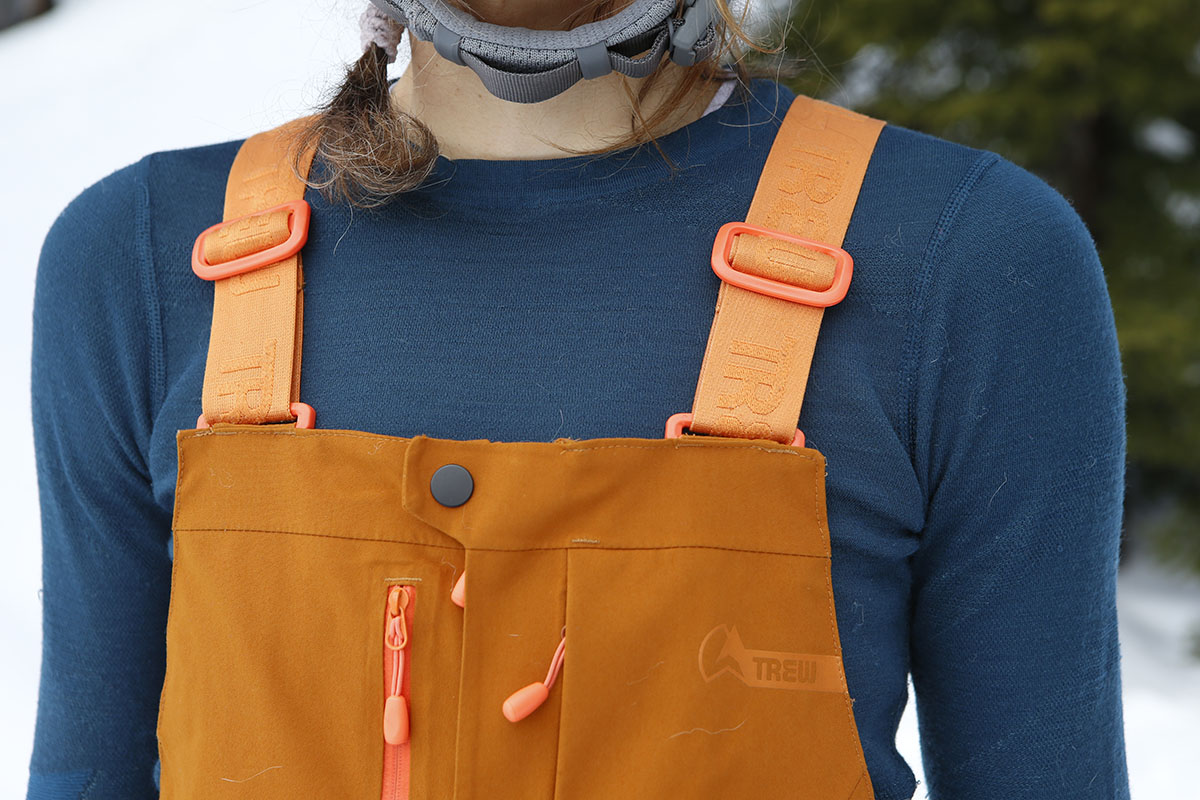
At 1 pound 15 ounces on my scale for a women’s small (1 lb. 12 oz. for a medium on Trew Gear’s website), the Chariot Bib Primo won’t be mistaken for a minimalist backcountry piece. Instead, it’s best suited for lift-accessed terrain and short tours when weight isn’t a huge consideration. For comparison, most similarly built designs are considerably lighter, including the Arc’teryx Sentinel Bib Pant (1 lb. 3.8 oz.), Flylow Gear Foxy Bib (1 lb. 6.9 oz.), and Outdoor Research Skytour AscentShell Bibs (1 lb. 7.6 oz.). To be fair, the Chariot’s excellent protection and durability do help justify the heft, but backcountry riders looking to keep weight to a minimum will want to look elsewhere.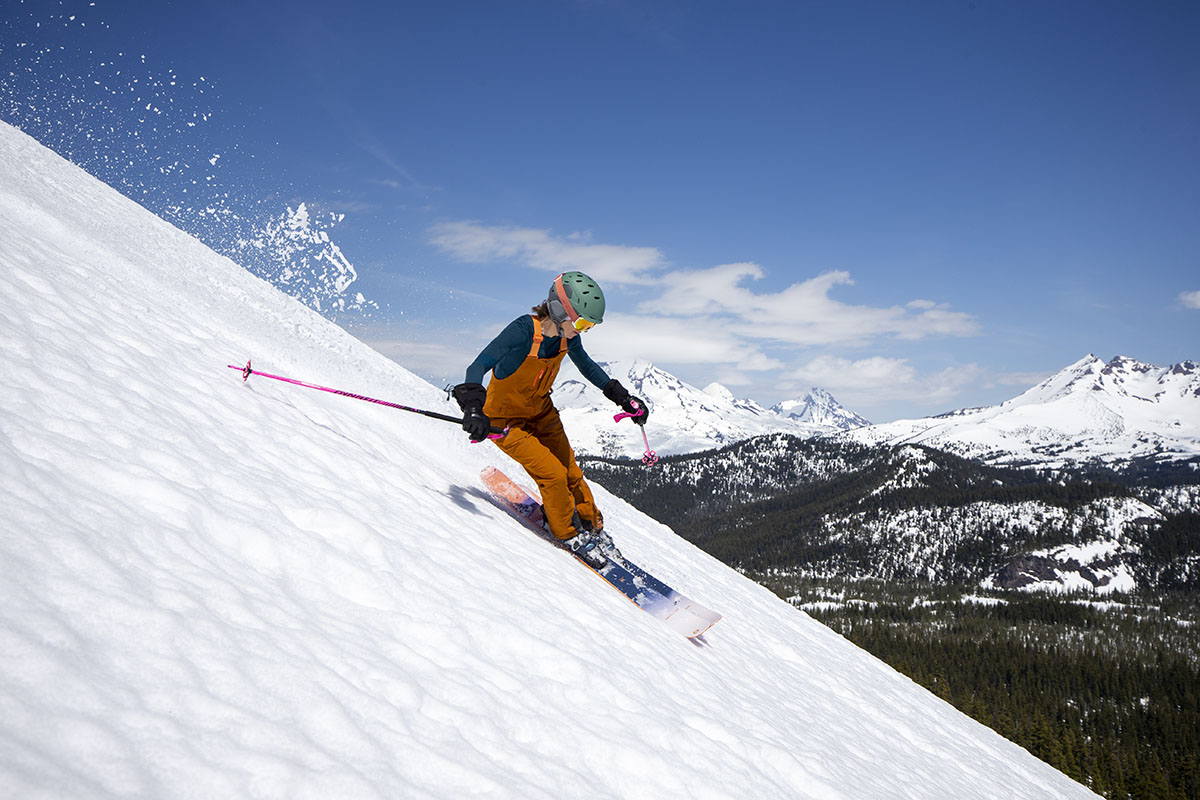
The Chariot Bib Primo leaves little to be desired in terms of storage with five well-placed pockets. Starting at the bottom, there are three pockets on the thighs: A deep zippered pocket on the left side, a shallower—but still beacon-friendly—zippered pocket on the right, and a flap-equipped pocket below that’s deeper than the right zip pocket and secured with a hook-and-loop (rather than zippered) closure. All three are large enough to stash items like a smartphone or field book and pencil for snowpack evaluation. Moving to the top, you get two zippered chest pockets that work well for a phone, lift pass, or other small valuables. Importantly, all of the zippered pockets use water-resistant zippers to prevent moisture from seeping in. Each of them also boasts an internal clip for securing an avalanche beacon, which is a rarity among the competition and a very thoughtful touch for touring since where you store your beacon is largely a matter of personal preference.![]()
Ski bibs can be a bit of a hassle when nature calls, which has been a deterrence for many women over the years. Thankfully, most modern designs come with either a full drop seat or swing hatch for bathroom breaks, and the Chariot Bib Primo is no exception. In this case, Trew Gear opted for a half-moon design with a water-resistant zipper that’s protected by a fabric flap for added assurance against moisture. In practice, the drop seat worked well at the lodge but wasn’t wide enough to allow for squatting in the backcountry. I also found that my baselayers tended to get bunched up when zipping the drop seat back up. Not all women will have the same experience, but I personally think the design would benefit from a couple improvements.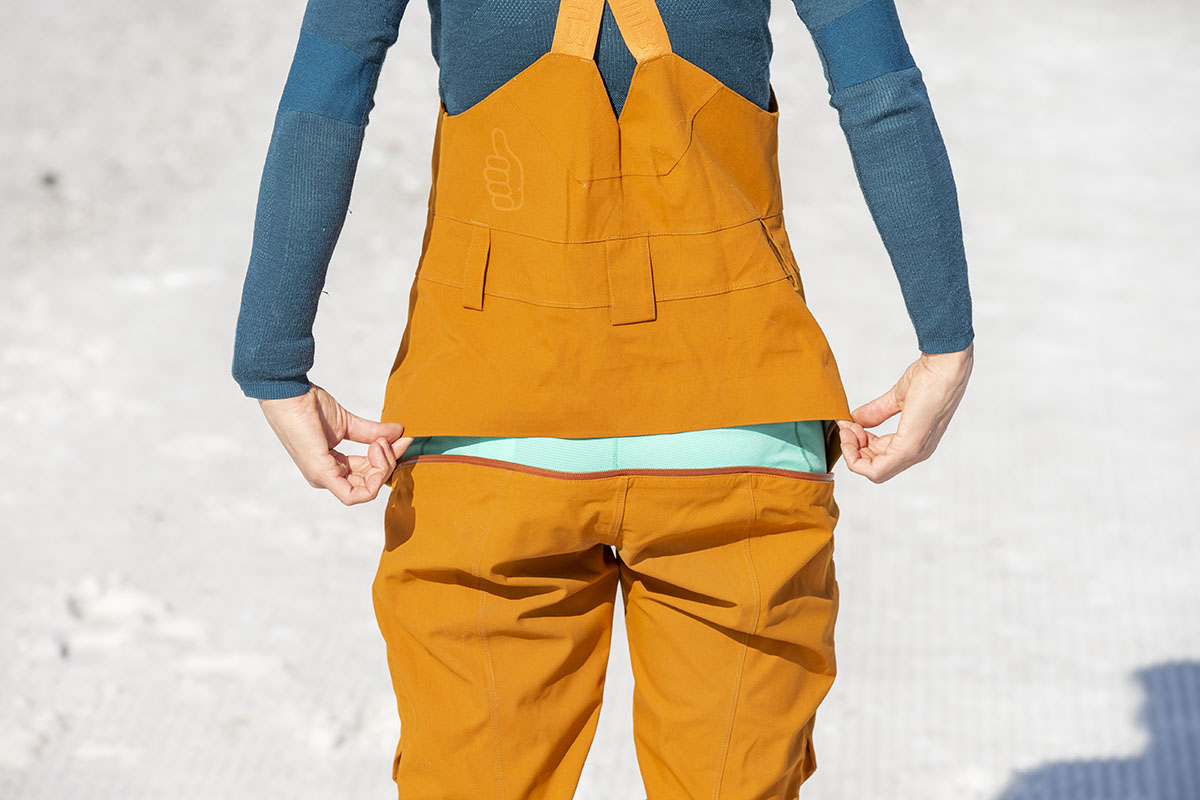
Rounding out the Chariot Bib Primo’s feature set are burly cuffs and internal gaiters for sealing out snow at the ankles. Starting with the former, the cuffs use an ultra-tough fabric around the bottom—dubbed SuperFabric—that extends about 8 inches up the inside of each leg for fending off scrapes and tears from sharp equipment like ski boots, bindings, or crampons. On the inside of the hem, gaiters extend down from the liner with elastic cuffs at the bottom to fit securely around your ski boot. Each gaiter also boasts two slits for accessing boot buckles and ski/walk levers without having to peel back the fabric, which is nice for frontcountry and backcountry riders alike. Finally, Trew Gear sewed a Recco reflector into the outer side of the left leg, which adds a nice dose of security in the event of a backcountry emergency.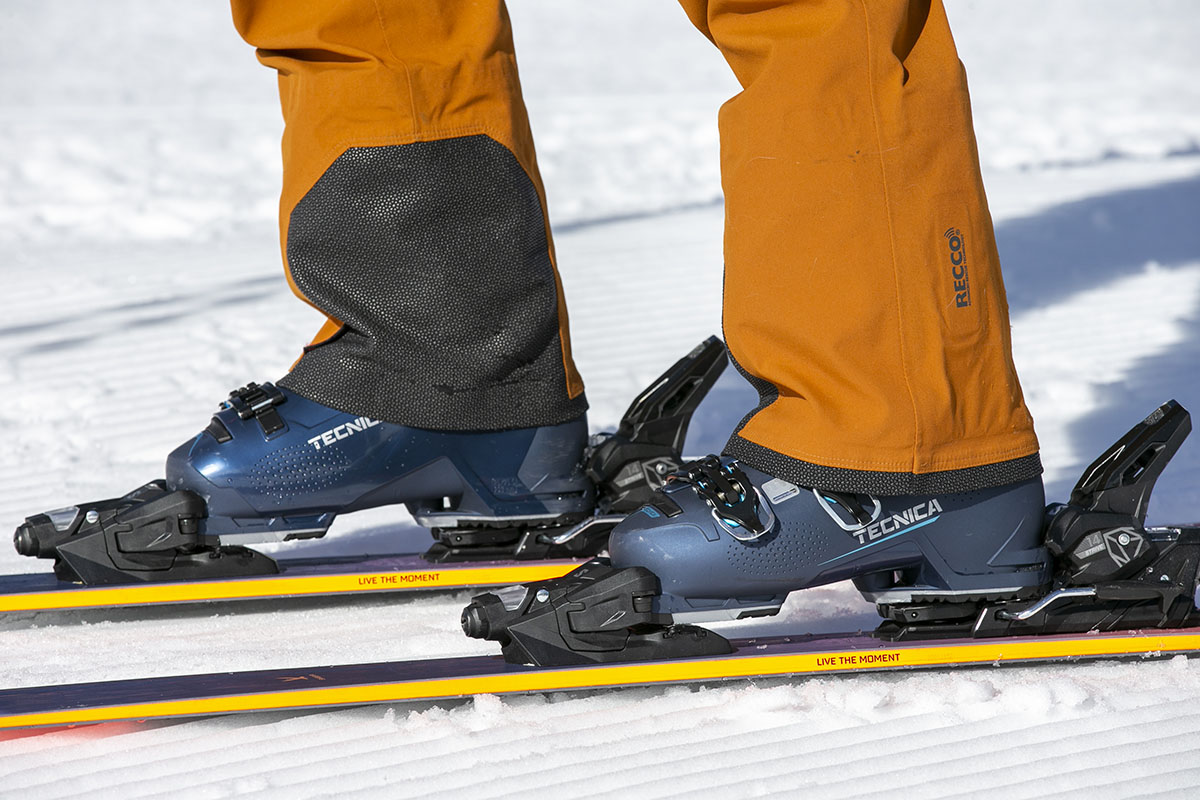
The Chariot Bib Primo boasts Trew Gear’s women’s-specific, relaxed “modern freeride" fit, which is meant to maximize mobility and allow room for layering underneath. For reference, I’m 5’7” with a 32-inch inseam and opted for my usual size small in the 32.5-inch inseam length (Trew Gear also offers the bibs in 30- and 35-in. inseams, as well as dedicated plus sizes up to 4X). The fit is indeed relaxed, but not so much that it feels ungainly or overly baggy, and I was able to move around freely without any restriction to movement. All told, I feel that Trew Gear nailed a really nice balance and consider the Chariot Bib’s fit to be one of its biggest selling points.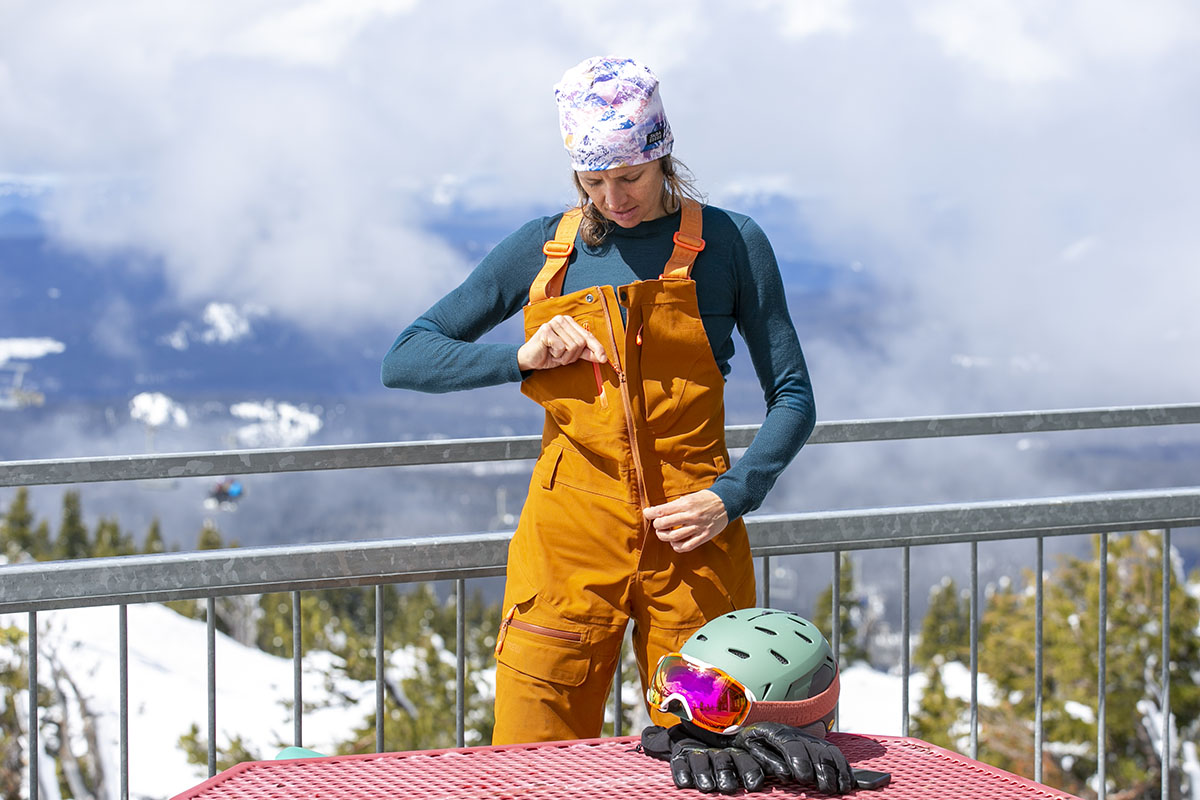
The outdoor industry has seen a sizable push on the sustainability front in recent years, and we commend Trew Gear for their continued efforts. In this case, the Chariot Bib Primo is built with a 100%-recycled nylon shell and is certified as bluesign-approved, which means it’s made without the use of harmful chemicals and considered safe for the environment, workers, and consumers. Some competitors have switched to PFC-free durable water repellent (DWR) coatings that are free from perfluorocarbons, and we’d love to see Trew Gear tack on a Fair Trade certification in the future, but the Chariot Bib Primo nevertheless scores solid marks when it comes to sustainability.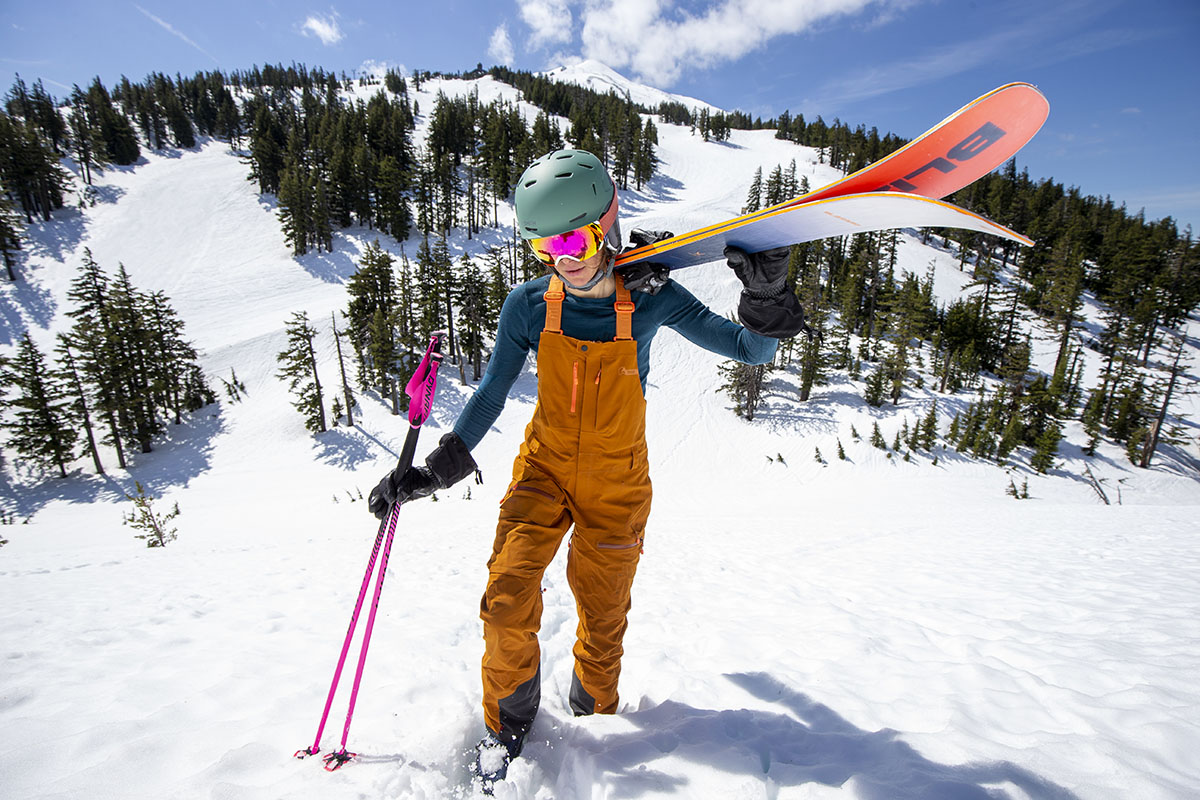
The Chariot Bib Primo is an upgraded version of Trew Gear’s flagship ski bib, the Chariot Bib Classic. The two designs are largely similar, including an identical feature set and the same relaxed “modern freeride” fit. The Classic weighs an ounce less and is $60 cheaper, although its 3-layer Classic construction is a small step down in durability, and there are no plus sizes available. On the men’s side, the Trewth Bib is the counterpart to the Chariot and also offered in both Classic and Primo versions. Compared to the Chariot Bib Primo tested here, the men’s Trewth Bib Primo boasts the same features and overall build—plus availability in three inseam lengths and extended sizing—but checks in a little heavier at 1 pound 15.5 ounces for a medium and is sold in different colorways.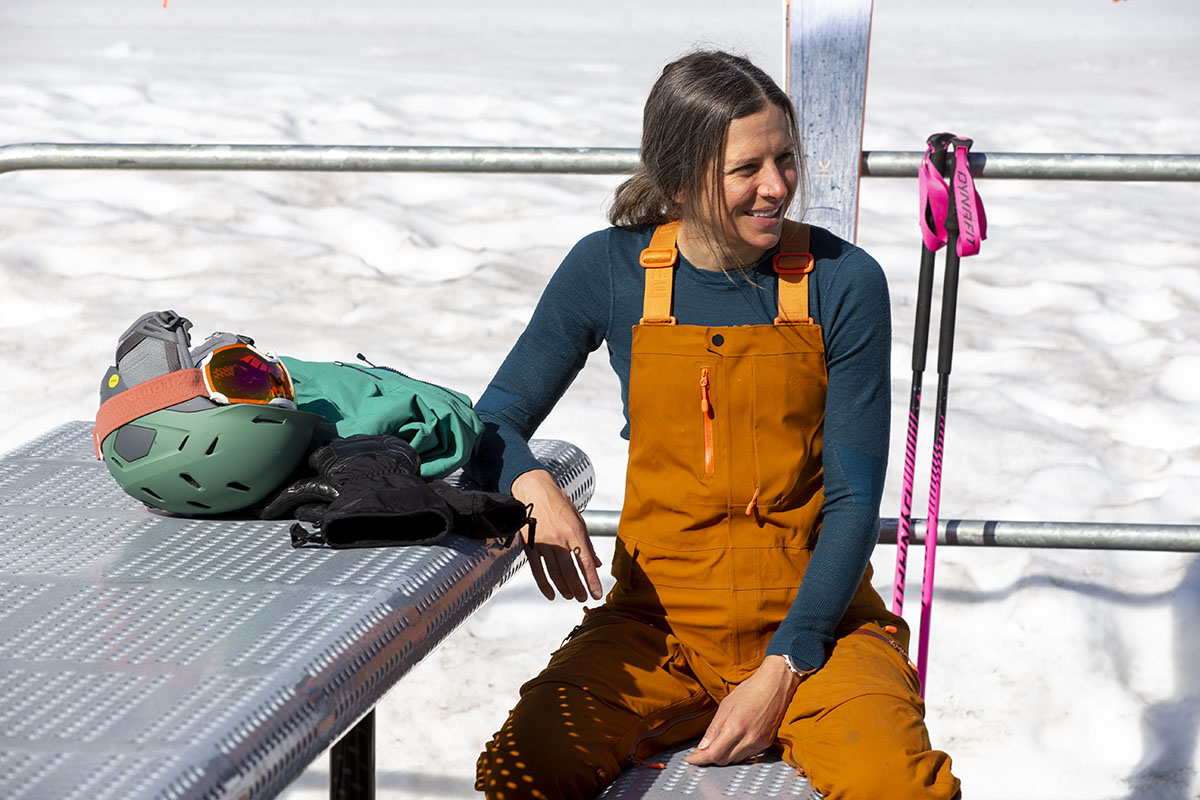
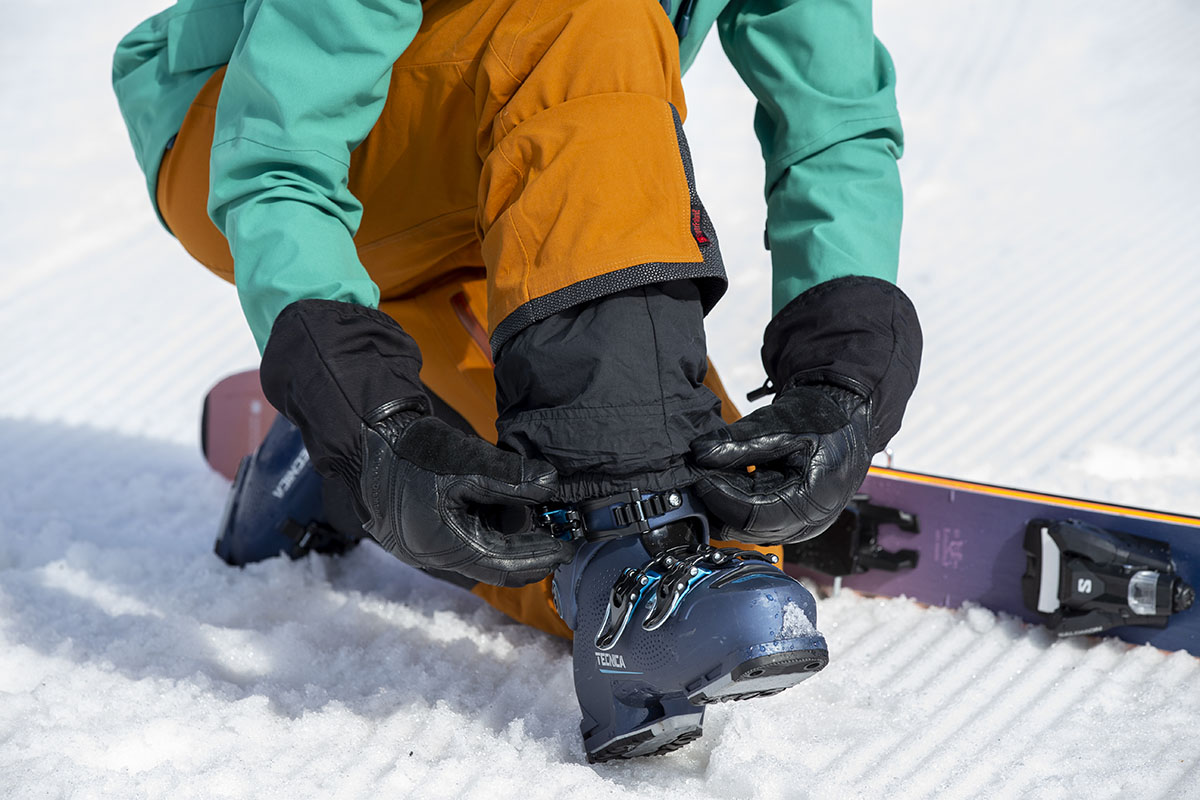
| Ski Bib | Price | Best for | Waterproofing | Weight | Pockets |
|---|---|---|---|---|---|
| Trew Gear Chariot Bib Primo | $499 | Resort/backcountry | 3L PNW Primo | 1 lb. 12 oz. | 5 |
| Flylow Gear Foxy Bib | $430 | Resort/backcountry | 3L Tactic | 1 lb. 6.9 oz. | 6 |
| Outdoor Research Carbide Bibs | $329 | Backcountry/resort | 3L Pertex Shield | 1 lb. 5.8 oz. | 3 |
| Trew Gear Capow Bib | $479 | Backcountry/resort | 3L Dermizax EV | 1 lb. 11 oz. | 4 |
| Black Diamond Recon Stretch | $450 | Backcountry/resort | 3L BD.dry | 1 lb. 9.4 oz. | 5 |
The Trew Gear Chariot Bib Primo is a highly protective and durable women’s ski bib, but it’s a little too thick and heavy for dedicated backcountry use. For similar appeal at a lower weight, we like Flylow Gear’s Foxy Bib, which checks in at 1 pound 6.9 ounces. Like the Chariot, the Foxy comes in three inseam lengths, has a modern and hip look, and offers great all-around durability. It’s also highly comfortable with a stretch-infused hardshell fabric and fully featured with vents on both the inside and outside of the thighs and no shortage of pockets. That said, the Foxy’s stretchy build sacrifices a little wet-weather protection compared to the more rigid Chariot, and backcountry users will be disappointed by the lack of beacon clip (for more, see our in-depth Foxy review here). These downsides are enough for us to prefer the Chariot, but the Foxy is a comfortable, stylish, and high-performing alternative at a $69 discount. ![]()
Next up is Outdoor Research’s Carbide, which is the least expensive alternative here at $329. Despite the drop in cost, OR managed to retain a 3-layer construction and relatively full feature set, including a beacon pocket with a clip at the chest, thigh vents, internal gaiters with power strap slots, and reinforced scuff guards at the cuffs. The two biggest drawbacks are durability and weather protection: The Carbide uses a relatively thin 40D face fabric that’s noticeably less robust than the Chariot’s, and the Pertex Shield membrane is a little less confidence-inspiring than Trew Gear’s PNW Primo construction—plus, OR opted for flaps rather than more protective water-resistant zippers. In the end, the Carbide is undeniably high on value, but committed skiers—especially those who frequent the resort—will benefit from spending up for the Trew Gear.
From within Trew Gear’s own lineup, we also like their Capow Bib. Instead of a traditional 3-layer construction, Trew Gear opted for a stretchy hardshell fabric along the lower part of the bib and breathable softshell at the top. Taken together, the Capow offers impressive comfort and mobility with far better breathability than the Chariot, making it the better option for high-output tours. It also has a wider fit through the legs, boasts a noticeably lower cut (it reaches about mid-torso), checks in 3 ounces lighter, and costs $20 less. In the end, we’d break it down as follows: The suppler and more ventilated Capow is the better backcountry companion, while the Chariot Bib Primo offers a step up in protection for inbounds riders.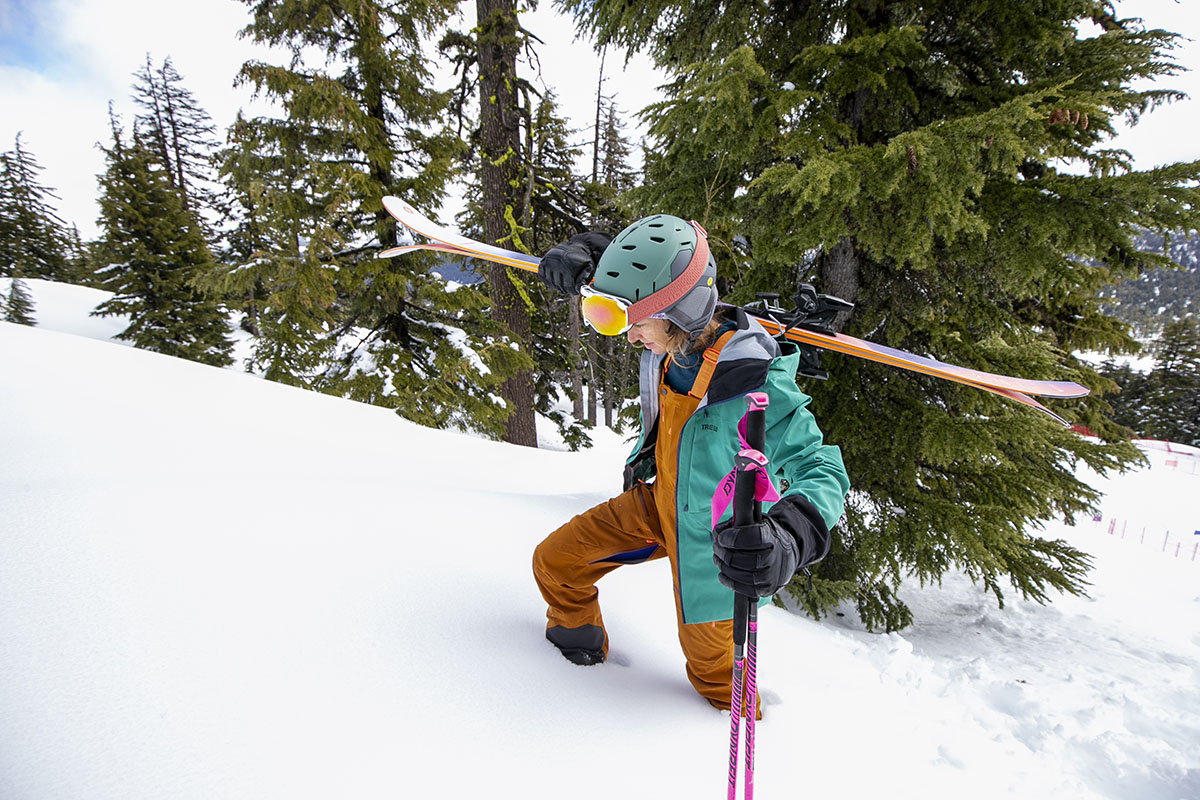
Last but not least is the Black Diamond Recon Stretch, which is a nice crossover option for mixed resort and backcountry use. For around $50 and 2.6 ounces less than the Chariot, the Recon features a stretchy 3-layer hardshell construction (hence its name) with generous softshell panels on both the front and back of the torso. The combination makes for great ventilation and mobility alongside decent waterproofing, although it’s a step down in all-out protection from the Chariot. Further, we don’t love the BD’s rear hatch design—there’s only one side zipper for access, which means you have to remove the shoulder straps during bathroom breaks. In the end, we feel the Chariot is worth the added investment for its advantages in weatherproofing and convenience, but the Recon Stretch isn’t too far behind and will save you some cash.
If you’re thinking about buying gear that we’ve reviewed on Switchback Travel, you can help support us in the process. Just click on any of the seller links above, and if you make a purchase, we receive a small percentage of the transaction. The cost of the product is the same to you but this helps us continue to test and write about outdoor gear. Thanks and we appreciate your support!
Depending on the seller, most products ship free in the United States on orders of $50 or more. International shipping availability and rates vary by seller. The pricing information on this page is updated hourly but we are not responsible for inaccuracies.